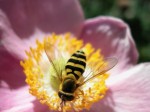 Here in the Western world, most of us go out of our way to avoid being stung by a bee. But in China, thousands are now paying to be stung by the honey-producing insects. Bee venom therapy, or apitherapy, as it’s more formally known, is doing big business in cities like Beijing.
Here in the Western world, most of us go out of our way to avoid being stung by a bee. But in China, thousands are now paying to be stung by the honey-producing insects. Bee venom therapy, or apitherapy, as it’s more formally known, is doing big business in cities like Beijing.
Apitherapy involves holding a bee at a specific point on the body and squeezing it until it stings the patient. The bee stings are used much like an acupuncture needle. Why does someone sign up for a dose of apitherapy? Practitioners who expound the health benefits of bee venom therapy say that it can help to cure life-threatening illnesses as well as treat other conditions that are not life-threatening but which affect a person’s quality of life.
Many medical experts in North America believe apitherapy to be a fraud as they see no clinical evidence that being stung by bees has a beneficial effect on health.
But for patients dealing with the often devastating symptoms of multiple sclerosis (MS) which can become progressively worse as the disease advances, apitherapy may be their best hope.
Despite some MS patients championing apitherapy, there are no clinical results which conclusively suggest a health benefit. Most clinical trial results are similar to those found by a team of University of Manitoba researchers. These scientists conducted a review of the effectiveness of a number of non-conventional treatments for MS. Included in this list was bee venom therapy. The researchers found “marginal support” for the therapy. They noted that studies failed to determine the active component of bee venom, while also mentioning the dangers of patients having an anaphylactic response.
Can Apitherapy Help Prevent Cancer? Korean Researchers Explore
Bee venom therapy is also being studied to determine its ability to prevent cancer. Korean researchers found that bee venom contains an active ingredient called melittin that can inhibit cell growth. They tested melittin-containing bee venom on ovarian cancer cells and found that melittin induced ovarian cancer cell death in a dose dependent manner.
It remains to be seen if bee therapy exerts any substantial benefits in the human body. Certainly, it’s true that other substances associated with bees, such as bee pollen and honey, have been found to have healing abilities. Honey has been studied for its beneficial effects in wound healing and bee pollen for its energy-boosting effects.
The debate about bee venom therapy will continue until large scale trials are conducted which clearly show positive results. In the mean time, there’s another group of citizens—besides skeptical medical professionals—that are concerned about the widespread use of apitherapy. Environmental activists have noted that after producing one of the forced bee stings, a bee will simply die. Bees have already been mysteriously dying in large numbers. The use of bee therapy will only exacerbate an already fragile insect population upon which humans rely to pollinate plants. As Einstein said, “if the bee disappeared off the face of the earth, man would only have four years left to live.”
Source(s) for Today’s Article:
Jo, M., et al., “Anti-cancer effect of bee venom toxin and melittin in ovarian cancer cells through induction of death receptors and inhibition of JAK2/STAT3 pathway,” Toxicol Appl Pharmacol. January 1, 2012; 258(1): 72-81.
Namaka, M., et al., “Examining the evidence: complementary adjunctive therapies for multiple sclerosis,” Neurol Res. September 2008; 30(7): 710-9.
“Bee sting therapy causing a buzz in China,” CTV News MyHealth web site, August 17, 2013; http://www.ctvnews.ca/health/bee-sting-therapy-causing-a-buzz-in-china-1.1415532, last accessed August 22, 2013.
